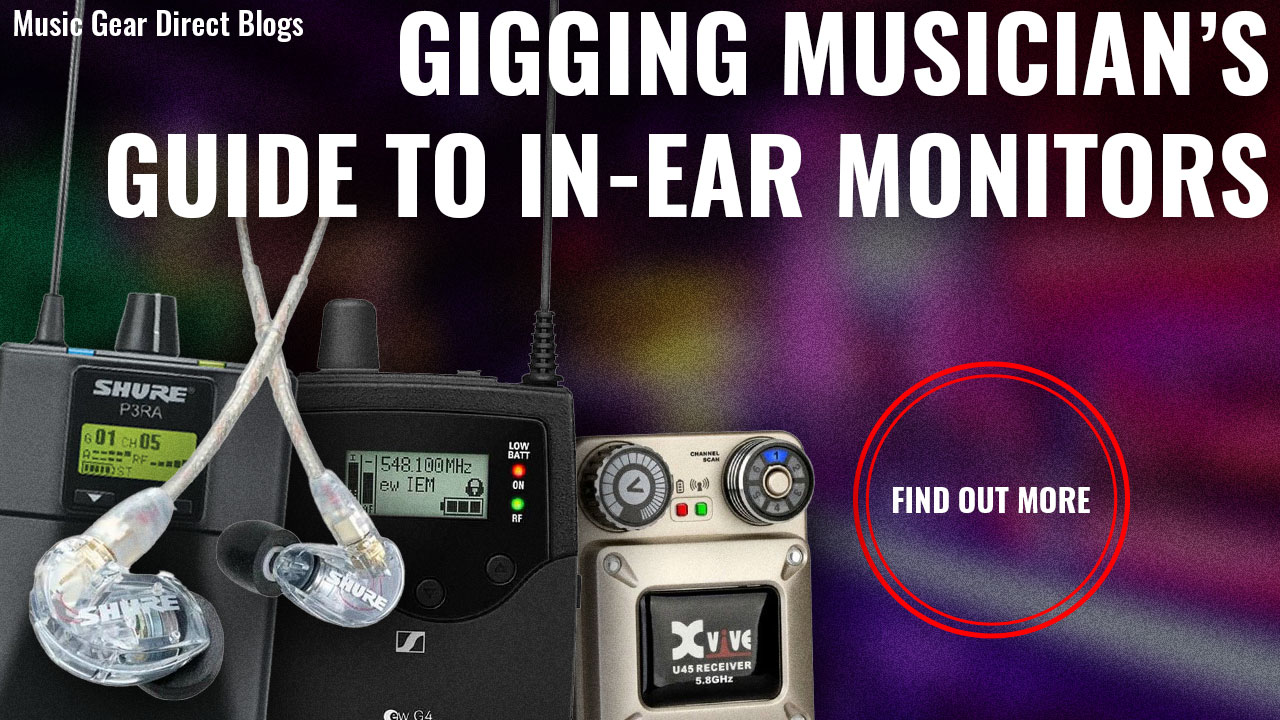Posted by Oli - Audio Expert at Music Gear Direct on 22nd May 2025
In-Ear Monitors - A Guide for Live Performers
The Gigging Musician’s Guide to In-Ear Monitors (IEMs)
If you’re a gigging musician, you’ve probably dealt with the joys and struggles of hearing yourself on stage. Maybe you’re used to floor wedges. Maybe you’ve dabbled with in-ear monitors (IEMs). Or maybe you’re just coming back to performing and wondering what’s changed. Spoiler: quite a bit.
IEMs used to be something only big touring acts used. Now? They’re everywhere — from pub gigs to festival stages. In this guide, we’ll break down what in-ear monitors are, how they work, and why they might just be your next best investment.
What Are In-Ear Monitors (IEMs)?
At a basic level, IEMs are earphones designed for live performers. They let you hear yourself and your band clearly — without all the messy noise from the crowd or other stage sounds.
Unlike traditional floor monitors, IEMs send your mix straight into your ears. The result? Less stage noise, better sound clarity, and more space on stage. If you move around a lot during your set, wireless IEMs give you full freedom to roam without tripping over a monitor.
An IEM setup typically includes:
-
A transmitter (usually off-stage)
-
A belt-pack receiver
-
Earphones that sit snugly in your ears
The transmitter sends the audio mix wirelessly to your receiver, which plays it through your earphones — all in real-time.
Why Use IEMs?
Here’s why more and more musicians are switching to IEMs:
Crystal-Clear Mix
Hear your vocals or instrument exactly the way you want, without competing with crowd noise or feedback from other monitors.
Less Gear, More Freedom
Fewer stage monitors = less clutter. And if you go wireless? You’re totally free to move around.
Better Sound Isolation
IEMs block out outside noise, letting you focus purely on your mix. Yes, it might feel strange at first to lose some of that connection with the audience, but your timing and performance will often improve as a result.
Customisable Fit
Most IEMs come in universal fits with different ear tip sizes. But if you’re gigging regularly, you might want to invest in custom-moulded IEMs made just for your ears. They’re ultra-comfortable and offer unbeatable isolation.
How Do IEMs Work?
The system is simple:
-
Your transmitter sends the mix.
-
Your receiver (belt pack) catches the signal.
-
Your earphones deliver the sound to your ears.
Many IEMs use balanced armature drivers (or a combination of armature and dynamic drivers) for precision and detail. The more drivers, the better the frequency separation — meaning clearer vocals, sharper instruments, and overall better sound.
Wireless IEMs use radio frequencies to transmit sound, while wired ones plug directly into the mixing desk — more stable, but less mobile.

Sound Quality & Isolation
Unlike regular earphones that may boost the bass or color the sound, IEMs aim for accuracy. That means you get a flat, balanced mix — exactly what’s being played.
Their passive noise isolation also helps protect your hearing. Since you’re not battling to hear over a loud stage, you don’t need to crank the volume.
Pro tip: Some advanced IEM setups even include ambient microphones to feed in crowd noise, so you don’t feel completely isolated from your audience.
Comfort & Fit
Comfort is key, especially for long sets. IEMs should sit snugly in your ears, with many using over-the-ear cables to stay secure.
If your IEMs are uncomfortable or keep falling out, chances are you’ve got the wrong size or style. Try different ear tips or consider custom-fit models for the best experience.
Wired vs. Wireless IEMs
Wireless IEMs
-
Most popular
-
Great for singers, guitarists, or anyone moving around on stage
-
More freedom, but you’ll need to manage potential signal dropouts
Wired IEMs
-
Best for drummers, keyboardists, or musicians who stay put
-
More stable connection
-
Less expensive, but you’re tethered to your rig
IEMs vs. Floor Monitors: Which Is Better?
Here’s a quick comparison to help you decide:
|
Feature |
In-Ear Monitors |
Floor Monitors |
|
Sound Clarity |
✅ Crystal clear and personalised |
⚠️ Can be muddy or drowned out |
|
Stage Space |
✅ Minimal gear |
❌ Takes up floor space |
|
Mobility |
✅ Wireless freedom |
❌ Static setup |
|
Connection to Audience |
⚠️ Isolated, unless using ambient mics |
✅ Natural sound and vibe |
|
Cost |
❌ Higher upfront |
✅ Budget-friendly |
What to Look for When Buying IEMs
Before you buy, consider:
-
Fit and comfort – Look for secure, snug-fitting earphones
-
Sound quality – More drivers = better frequency clarity
-
Wireless vs. wired – Choose based on how much you move on stage
-
Durability – Trusted brands like Shure and Sennheiser are built to last
FAQs
What are IEMs used for?
To give musicians a clear, personalised mix of their performance while reducing stage noise and protecting their hearing.
Any downsides?
The biggest challenge is getting the right fit. Poor fit = poor sound isolation and earphones that fall out mid-song.
Are IEMs worth it?
Absolutely — especially if you’re gigging regularly. Better sound, less noise, more control over your mix.
Final Thoughts
Whether you’re playing local pubs or planning a tour, in-ear monitors can seriously level up your stage game. They’re compact, powerful, and designed to help you perform your best — with a clearer mix and healthier ears.
If you’re thinking of making the switch, now’s the time. You’ll wonder how you ever played without them.
Our pick for universal fit in ear monitors are the Shure SE215.
Click here to check out our range of In Ear Monitor Systems
Don't see exactly what you're looking for? We can help! Call us on 01159383892 Mon - Fri 9:30am to 4pm / Sat 10am to 2pm or send us a message here.



